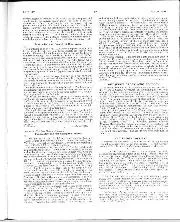
Rex Judd's Brooklands Re-Union
The annual re-union of Brooklands motorcyclists was held at the "Hand & Spear," Weybridge, on the evening of April 30th, organised by Rex Judd, who, in spite of a recent…
Forty years on, remember the tumultuous F1 season of 1982? It boasted a larger cast of leading characters than usual – almost anyone could win. Any team which did not couldn’t amount to much.
Initially it promised to be the great crunch season – the last gasp – for the atmospherically aspirated engines from Cosworth, Talbot-Ligier and Alfa Romeo. The turbos were coming, Ferrari and Renault nearing full song, BMW and Alfa Romeo threatening and low-budget Toleman-Hart wrestling. But none could foresee Ferrari’s tragedies, nor Renault’s continued unreliability, while BMW fought to develop its ostensibly humble four-cylinder.
Williams had dominated the Constructors’ Championship through 1980-81. Frank wanted dearly to match Ferrari’s ’70s hat-trick. His loss of both Alan Jones and Carlos Reutemann demolished such ambition. A champion team needed two frontline drivers. At the time, Williams’s late signings – Keke Rosberg and Derek Daly – were not that, and while the Constructors’ title fell to Ferrari despite
the loss of both Gilles Villeneuve (deceased) and Didier Pironi (maimed), McLaren and Renault placed 2-3 before Williams, fourth, but salvaging the Driver’s title with Keke.
Technically, 1982 was more complex than a simple turbocharged vs un-turbocharged duel. The atmo teams suffered instant disadvantage pre-race, since the turbos would qualify faster and pack the front grid rows. In addition, tyre influence was amplified and changes in weight and aerodynamic skirt regulations created engineering challenges.
“A Ricard test used up nine engines, and the French GP seven or eight”
Round two in Brazil heralded difficulty. Nelson Piquet won for Brabham from Rosberg’s Williams and Prost’s Renault. All had been battered by stiff suspension necessary to keep new-regulation fixed – no longer sliding – side skirts effective. To keep competitive with the turbos, Brabham, Williams and others started with large water bottles full “to cool the brakes”. Immediately on track that water was dumped – “disposable ballast!” screamed Renault, seeking rule clarification by protest. After initial rejection their plea was upheld at appeal – Piquet and Rosberg disqualified.
Ten FOCA teams boycotted Imola, 14 cars started, and with only seven still running it seemed that Ferrari was putting on a show, Villeneuve vs Pironi. That all turned poisonous between the two, prelude to tragic history…
After Villeneuve’s death at Zolder, Pironi seemed set for the title. During 1981 when Ferrari’s turbo V6 began winning the feeling had been “If Ferrari ever get a halfway decent chassis we’ll never see which way they went…”. That proved not true but new recruit Harvey Postlethwaite PhD introduced the Italian team to carbon-composite technology very quickly.
Incumbent chief engineer Mauro Forghieri: “Postlethwaite was invited for his knowledge of aluminium-honeycomb chassis. When asked about carbon composite he’d say ‘I know nothing – I have never built one’”. The Doc and Ferrari learned together. Once set up, producing the first 126C2 took around a month. Later Ferrari could crack-out a tub in 40 hours.
Tyre consumption was an early-season problem. Ferrari rapidly followed Gordon Murray’s lead in scrapping rocker-arm front suspension because, with tiny modern suspension movements, rocker arms had to resist colossal loads and behaved like undamped springs. They had to be massive and so were both heavy and bulky, frontal area generating wasteful drag. At a stroke, pull-rod suspension gave useful rising-rate geometry, slimmed-down top wishbones minimised drag and thereafter Ferrari flew. All development work suffered after Pironi’s Hockenheim crash; concentration thereafter was to play-in new drivers Tambay and Andretti and salvage whatever possible from that shattered season.
McLaren’s year seemed untroubled save for their Michelin radial-ply tyres squidging under load at high speed, taking up ground clearance. In contrast cross-ply Goodyear tyres grew, resisting aerodynamic downforce. Michelin developments helped later, while McLaren followed another Murray/Brabham lead with carbon brake disc experiments.
Renault endured a troubled electro-mechanical fuel injection system. Team chief Jean Sage: “We ran both cars, both drivers, with conventional injection and they were consistently 2secs a lap slower. We dare not discard such advantage for reliability which might or might not come…”. That cost them.
And then there was Williams. Their FW08 was the minimum car, Rosberg the maximum driver. Derek Daly was considered “a super race driver” but indifferent qualifying left him too often starting mid-grid.
Brabham was dominated by BMW turbo engine development, but they won three early races – two with the Cosworth, then Canada 1-2 with their BT50 BMW car leading home the BT49D Cosworth. Gordon Murray regretted how “a Ricard test used up nine engines, and the French GP seven or eight”.
Another 1982 anniversary recalls Gordon’s short-fuelled, mid-race pitstop strategy to refuel and fit soft-compound tyres. Planned for Brands Hatch, Ricard and Hockenheim only for the cars to fail before half-distance, the ploy was introduced in Austria – only for unreliability to intervene.
Other winners that year were Lotus and Tyrrell. Talbot-Ligier threatened, but for the rest there was always the thought “Frank Williams was once one of us”.
Doug Nye is the UK’s leading motor racing historian and has been writing authoritatively about the sport since the 1960s